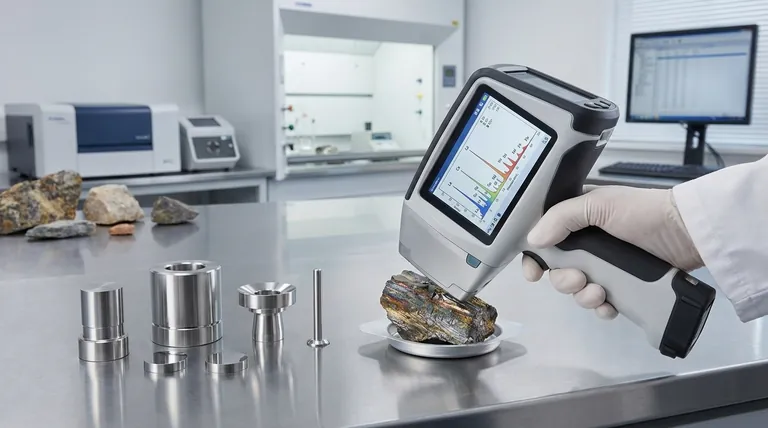Да, рентгенофлуоресцентный анализ (РФА) является широко используемой и эффективной технологией для обнаружения редкоземельных элементов (РЗЭ). Это стандартный метод в горнодобывающей разведке, геологии и переработке для обеспечения быстрого, неразрушающего элементного анализа. Однако эффективность и точность анализа сильно зависят от типа используемого РФА-прибора, конкретных целевых РЗЭ и сложности сканируемого материала.
Основной вывод заключается в том, что, хотя РФА является незаменимым инструментом для быстрого, полуколичественного скрининга РЗЭ, достижение точных, лабораторных результатов требует глубокого понимания его внутренних ограничений — особенно перекрытия спектральных пиков и матричных эффектов — и часто требует подтверждения другими аналитическими методами.

Как РФА идентифицирует редкоземельные элементы
Принцип рентгенофлуоресценции
По своей сути, РФА-анализ представляет собой двухэтапный процесс. Сначала прибор бомбардирует образец высокоэнергетическими первичными рентгеновскими лучами. Эта энергия возбуждает атомы в образце, заставляя их выбрасывать электрон с внутренней орбитальной оболочки.
Для восстановления стабильности электрон с внешней оболочки с более высокой энергией немедленно опускается, чтобы заполнить вакансию. Этот переход высвобождает определенное количество энергии в виде вторичного рентгеновского излучения, которое является «флуоресценцией», измеряемой детектором прибора.
Спектральные сигнатуры РЗЭ
Важно отметить, что энергия этого вторичного рентгеновского излучения уникальна для элемента, из которого оно было испущено. Каждый редкоземельный элемент имеет характерный «отпечаток» или сигнатуру энергий рентгеновского излучения.
Основными спектральными линиями, используемыми для идентификации РЗЭ, являются линии L-серии. Это связано с тем, что линии K-серии для этих тяжелых элементов требуют чрезвычайно высокой энергии для возбуждения, часто превышающей возможности стандартного РФА-оборудования.
Роль современных детекторов
Современные РФА-анализаторы, особенно портативные устройства, используют сложные кремниевые дрейфовые детекторы (SDD). Эти детекторы способны обрабатывать тысячи рентгеновских импульсов в секунду и обладают разрешением, необходимым для различения часто переполненных линий L-серии различных РЗЭ.
Практические проблемы анализа РЗЭ с помощью РФА
Хотя принцип прост, реальный анализ РЗЭ представляет собой серьезные проблемы, которые необходимо понимать для правильной интерпретации данных.
Проблема спектральных перекрытий
Это самая большая проблема в РФА-анализе РЗЭ. Периодическая таблица плотно заполнена элементами в этой области, и их эмиссионные линии L-серии многочисленны и часто очень близки друг к другу.
Это создает значительные перекрытия пиков, когда сигнал от одного элемента мешает сигналу другого или ошибочно принимается за него. Например, линия Lα празеодима (Pr) может перекрываться с линией Lβ лантана (La), а линии бария (Ba) могут мешать церию (Ce). Коррекция этих перекрытий требует сложного программного обеспечения и тщательной калибровки.
Легкие и тяжелые РЗЭ
РФА обычно более чувствителен к тяжелым РЗЭ (ТРЗЭ), таким как гадолиний (Gd) и иттрий (Y), чем к легким РЗЭ (ЛРЗЭ), таким как лантан (La) и церий (Ce).
Рентгеновские лучи, испускаемые ЛРЗЭ, имеют более низкую энергию. Эти низкоэнергетические фотоны легче поглощаются окружающим материалом образца (матрицей) и даже воздухом между образцом и детектором, ослабляя их сигнал.
Матричные эффекты
Состав материала, окружающего РЗЭ, оказывает большое влияние на результаты. Это известно как матричный эффект.
Тяжелая матрица, например, богатая железом или свинцом, может поглощать флуоресцентные рентгеновские лучи от РЗЭ, что приводит к искусственно заниженным показаниям. И наоборот, легкая матрица, такая как кремнезем, будет иметь меньший эффект. Точное количественное определение требует, чтобы ваши калибровочные стандарты точно соответствовали матрице ваших неизвестных образцов.
Пределы обнаружения
РФА — это метод объемного анализа, а не метод следового анализа. Для РЗЭ пределы обнаружения (ПО) для портативного РФА обычно находятся в диапазоне от 10 до 100 частей на миллион (ppm) в идеальных условиях. Для точного измерения более низких концентраций необходимо обратиться к лабораторным методам, таким как ИСП-МС.
Правильный выбор для вашей цели
Правильный подход полностью зависит от вашей цели. РФА — это не единственное решение, а универсальный инструмент с различными применениями.
- Если ваша основная задача — быстрый полевой скрининг или геологическая разведка: Ручной РФА не имеет себе равных. Он позволяет идентифицировать руды, содержащие РЗЭ, и принимать немедленные решения о том, куда направить дальнейшие исследования.
- Если ваша основная задача — контроль процесса или сортировка материалов (например, переработка): Ручной РФА обеспечивает скорость, необходимую для проверки качества материалов на конвейерной ленте или сортировки сплавов и электронных отходов, содержащих РЗЭ.
- Если ваша основная задача — точный количественный анализ для отчетности или исследований: Используйте РФА в качестве инструмента предварительного скрининга, но полагайтесь на лабораторные методы, такие как ИСП-МС (индуктивно-связанная плазменная масс-спектрометрия) для окончательных, сертифицируемых результатов, особенно для низких концентраций.
В конечном итоге, эффективное использование РФА для редкоземельных элементов означает использование его преимуществ в скорости и доступности при уважении его ограничений в точности и чувствительности.
Сводная таблица:
| Применение | Пригодность РФА | Ключевые соображения |
|---|---|---|
| Полевая разведка и скрининг | Отлично | Быстро, неразрушающе; идеально для идентификации руд, содержащих РЗЭ. |
| Контроль процессов и сортировка материалов | Отлично | Быстрый анализ для переработки и проверки качества. |
| Точный количественный анализ | Ограничено (инструмент скрининга) | Требует подтверждения лабораторными методами, такими как ИСП-МС, для низких концентраций. |
Оптимизируйте анализ редкоземельных элементов с помощью правильного оборудования. KINTEK специализируется на лабораторном оборудовании и расходных материалах, удовлетворяя лабораторные потребности с помощью точных РФА-анализаторов и экспертной поддержки. Независимо от того, занимаетесь ли вы горнодобывающей разведкой, переработкой или исследованиями, наши решения обеспечивают быстрые и надежные результаты. Свяжитесь с нашими экспертами сегодня, чтобы найти идеальный РФА-инструмент для ваших конкретных задач по обнаружению РЗЭ!
Визуальное руководство

Связанные товары
- Лабораторная пресс-форма для таблеток из борной кислоты для рентгенофлуоресцентного анализа
- Лабораторная шаровая мельница с алюминиевой циркониевой помольной емкостью и шариками
- Подложка из оптического оконного стекла, пластина из фторида бария BaF2
- Подложка из оптического оконного стекла, подложка из CaF2, оконная линза
- Цилиндрическая пресс-форма Assemble Lab
Люди также спрашивают
- В чем разница между ЭДС и РФА? ЭДС для микроанализа, РФА для объемного анализа
- Какова продолжительность жизни плесени? Она бессмертна, если вы не контролируете влажность
- Из чего изготавливаются матрицы для прессования таблеток? Выберите правильный материал для точного рентгенофлуоресцентного анализа
- Как сделать таблетки для РФА? Пошаговое руководство по безупречной подготовке образцов
- Как подготовить образец для рентгенофлуоресцентного анализа (XRF)? Освойте ключевые методы для получения точных результатов


















